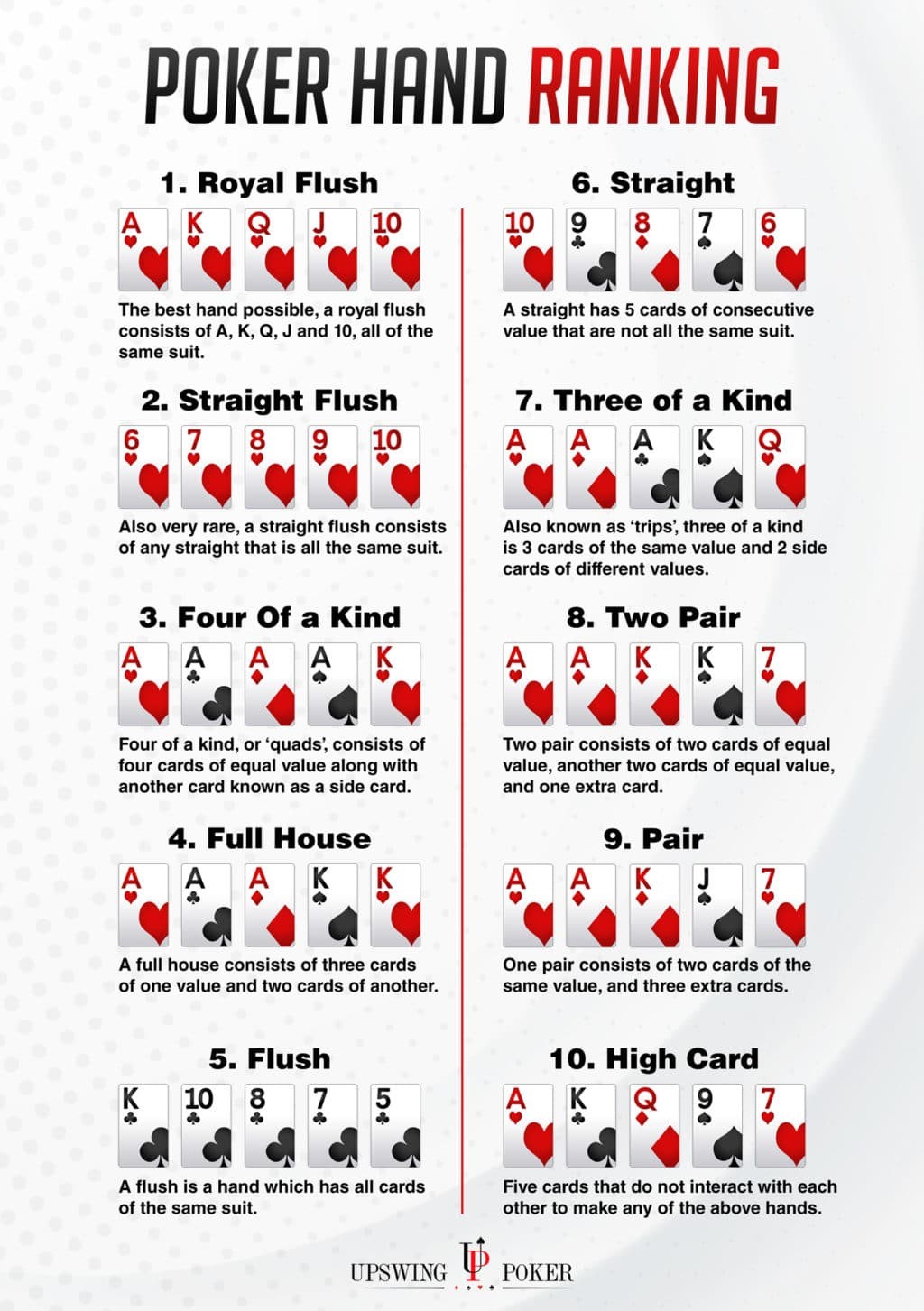Poker Game Guide offers a comprehensive overview of poker, covering essential rules, hand rankings, and betting structures. CONDUCT.EDU.VN helps players of all levels master this classic card game, from Texas Hold’em to Omaha, guiding you to improve your gameplay with confidence. Level up your poker prowess with expert insights, essential poker rules and valuable gaming strategies.
1. Understanding Poker Hand Rankings
In poker, the value of your hand determines your chances of winning. Most poker variants use a standard hand ranking system. Familiarizing yourself with these rankings is essential for making informed decisions during gameplay.
1.1 Standard Poker Hand Rankings
Here’s a breakdown of the standard poker hand rankings, from highest to lowest:
- Royal Flush: A straight flush consisting of Ace, King, Queen, Jack, and Ten, all of the same suit. This is the highest possible hand in poker.
- Straight Flush: Any straight consisting of five cards of the same suit. For example, 9, 8, 7, 6, and 5 of hearts.
- Four of a Kind: Four cards of the same rank, such as four Queens.
- Full House: A combination of three of a kind and a pair, such as three 8s and two 4s.
- Flush: Any five cards of the same suit, but not in a sequence.
- Straight: Five cards in a sequence, but not of the same suit.
- Three of a Kind: Three cards of the same rank, such as three 7s.
- Two Pair: Two different pairs of cards, such as two Jacks and two 3s.
- One Pair: Two cards of the same rank, such as two 10s.
- High Card: When no other hand is made, the highest card determines the hand’s value.
1.2 Lowball Hand Rankings
Some poker variants, known as lowball games, use a different hand ranking system where the lowest hand wins. In A-5 lowball (also known as California lowball), the best hand is A-2-3-4-5, with Aces always counting as low. Straights and flushes are not counted against you in this variant. Deuce-to-Seven lowball, on the other hand, does count straights and flushes, making 2-3-4-5-7 the best possible hand.
Understanding these hand rankings is essential for playing poker effectively. For more in-depth information on poker hand rankings, including examples and tie-breaking scenarios, visit CONDUCT.EDU.VN. We provide clear and comprehensive guides to help you master the game.
2. The Role of Blinds and Antes in Poker
Blinds and antes are forced bets that add initial money to the pot, encouraging action and ensuring that there is something to play for in every hand. Understanding how they work is crucial for any poker player.
2.1 Understanding Blinds
In poker games that use blinds, such as Texas Hold’em and Omaha, two players are required to make mandatory bets before each hand begins.
- Small Blind: The player directly to the left of the dealer button posts the small blind, which is typically half the amount of the big blind.
- Big Blind: The player to the left of the small blind posts the big blind, which is the minimum bet allowed in the first round of betting.
These blinds rotate around the table with each hand, ensuring that every player pays their dues. The size of the blinds is usually indicated in the game listing. For example, in a $1/$2 game, the small blind is $1 and the big blind is $2.
2.2 The Purpose of Antes
Antes are mandatory bets that all players at the table must contribute before the hand begins. These are used in some poker formats to further incentivize action. The dealer collects the antes and adds them to the pot before dealing any cards. For example, a $5/$10 game with a $1 ante requires each player to put $1 into the pot before each hand. This is in addition to the blinds, resulting in larger starting pots.
Understanding the mechanics of blinds and antes is vital for developing a solid poker strategy. To learn more about how these forced bets impact gameplay, visit CONDUCT.EDU.VN. We offer detailed guides and insights to help you succeed at the poker table.
3. Limit Versus No Limit Betting Structures
Poker games come in various formats, but the most common distinction lies in their betting structures: limit and no limit. Understanding these structures is fundamental to crafting effective strategies and managing your bankroll.
3.1 No-Limit Poker
In no-limit poker, players can bet any amount up to all of their chips at any time. This format allows for aggressive play and high-stakes confrontations.
- Any Bet Size: Players can bet any amount they choose, from the minimum bet to their entire stack.
- All-In Option: At any point during a hand, a player can wager all their chips, known as going “all-in.”
- Strategic Implications: No-limit games require careful consideration of bet sizing, bluffing opportunities, and risk management.
3.2 Limit Poker
Limit poker games have structured betting limits for each round. This format emphasizes strategic decision-making based on fixed bet sizes.
- Small Bet/Big Bet: Limit games use a “small bet” and a “big bet.” The big blind usually equals the small bet.
- Betting Caps: The maximum bet or raise is limited to the small bet in early rounds and increases to the big bet in later rounds.
- Limited Raises: Betting is often “capped” after a certain number of raises (typically three), after which players can only call.
| Feature | No-Limit Poker | Limit Poker |
|---|---|---|
| Betting Range | Any amount up to all chips | Fixed amounts (small bet/big bet) |
| Risk Management | High; potential for large swings | Lower; more controlled betting |
| Strategy | Emphasis on bet sizing, bluffing, and timing | Emphasis on odds, implied odds, and value bets |




4. Key Actions in a Poker Hand
During a poker hand, players have several actions they can take, each with strategic implications. Understanding these options is essential for making informed decisions and navigating the game effectively.
4.1 Available Actions
- Call: Matching the amount of the current bet or raise.
- Raise: Increasing the amount of the current bet, forcing subsequent players to call the new amount or fold.
- Fold: Discarding your hand and forfeiting any chance of winning the pot.
- Check: Passing the action to the next player without betting, only allowed when there is no current bet or raise.
These actions form the foundation of poker gameplay. Strategic use of these options can influence the outcome of a hand and your overall success at the table.
5. Understanding Table Stakes in Poker
Table stakes refer to the rules governing the amount of money a player can bring to the table and risk in a single game or tournament. This concept is crucial for bankroll management and understanding the dynamics of different poker formats.
5.1 Cash Game Stakes
In cash games, players buy in with real money and can leave the game at any time, cashing out their chips. The stakes are usually displayed as “small blind/big blind,” such as “$1/$2 NL Hold’em,” which indicates a No-Limit Texas Hold’em game with a $1 small blind and $2 big blind.
- Standard Buy-In: The standard buy-in for a no-limit cash game is typically 100 times the big blind. For example, a $1/$2 NL game would have a standard buy-in of $200.
- Notation: Games are often listed as “200NL,” meaning a $1/$2 No-Limit Hold’em game with a maximum buy-in of $200, equivalent to 100 big blinds.
5.2 Tournament Stakes
In tournaments, players pay a fixed buy-in to receive a set amount of chips. The blinds increase at regular intervals, and players are eliminated as they lose their chips. Tournament chips have no cash value.
- Blind Structure: Blind amounts increase at regular intervals, creating urgency and encouraging action.
- Prize Pool: The total buy-ins from all players form the prize pool, which is distributed among the top finishers according to a predetermined payout structure.
Understanding table stakes is critical for choosing the right games and managing your bankroll effectively.
A big stack of chips in the World Series of Poker Main Event.
6. Basic Texas Hold’em Rules: A Step-by-Step Guide
Texas Hold’em is the world’s most popular poker game, played in casinos, online, and in home games around the globe. Learning the basic rules is the first step to mastering this exciting game.
6.1 Game Objective
The object of Texas Hold’em is to make the best five-card poker hand using any combination of your two private hole cards and five community cards.
6.2 Gameplay Overview
- Dealing Hole Cards: Each player receives two private hole cards, dealt face down.
- Preflop Betting Round: The first betting round begins after the hole cards are dealt, starting with the player to the left of the big blind.
- The Flop: Three community cards are dealt face up in the center of the table.
- Flop Betting Round: Another round of betting occurs after the flop.
- The Turn: A fourth community card is dealt face up.
- Turn Betting Round: Another round of betting takes place after the turn.
- The River: A fifth and final community card is dealt face up.
- River Betting Round: The final round of betting occurs after the river.
- Showdown: If more than one player remains after the final betting round, the players reveal their hole cards, and the player with the best five-card hand wins the pot.
Following these steps will ensure you understand the basic flow of a Texas Hold’em game. For a more detailed explanation of Texas Hold’em rules and strategy, visit CONDUCT.EDU.VN.
7. Basic Omaha Poker Rules: Key Differences from Texas Hold’em
Omaha Hold’em, also known simply as Omaha, shares similarities with Texas Hold’em but has some crucial differences. Mastering these differences is essential for playing Omaha effectively.
7.1 Distinctive Features of Omaha
- Four Hole Cards: In Omaha, each player is dealt four private hole cards instead of two.
- Hand Construction: Players must use exactly two hole cards and three community cards to make their five-card hand.
- Variants: Common versions of Omaha include regular Omaha and Omaha Hi-Lo (Omaha Eight or Better).
7.2 Gameplay Overview
The gameplay of Omaha is similar to Texas Hold’em, with preflop, flop, turn, and river betting rounds. However, the requirement to use exactly two hole cards adds a unique strategic element to the game.
7.3 Pot Limit Omaha (PLO)
Pot Limit Omaha, commonly called PLO, is the second-most popular poker game in the world, after Texas Hold’em. It is usually played with pot-limit betting rules.
Understanding these differences is key to excelling at Omaha. For a comprehensive guide to Omaha rules and strategy, visit CONDUCT.EDU.VN.
8. Exploring Other Poker Variants
While Texas Hold’em and Omaha are the most popular forms of poker, numerous other variants offer unique gameplay experiences. Here are a few notable examples:
8.1 Seven Card Stud
Seven Card Stud is a classic poker game played with limit betting rules. Each player receives seven unique cards, but unlike Hold’em and Omaha, there are no community cards. Players must make the best five-card hand from their seven cards.
- Antes and Bring-In: Each player posts an ante, and the player with the lowest-ranking door card posts a forced bet called the bring-in.
- No Community Cards: Players make their hands using only the cards they are dealt.
8.2 Razz
Razz is a variant of Stud where the lowest hand wins. It follows the A-to-5 lowball hand rankings, with aces counting as low and straights and flushes not counting against your hand.
- Low Hand Wins: The goal is to make the lowest possible hand.
- No High Hands: There are no qualifications for low hands; the lowest hand wins.
8.3 Hi-Lo Games
Hi-Lo games, also known as split-pot games, divide the pot between the best high hand and the best low hand. The low hand must qualify with at least five cards below 8, using A-to-5 lowball rankings.
- Split Pot: The pot is divided between the high and low hands.
- Qualifying Low Hand: The low hand must have five cards below 8 to qualify.
8.4 Short Deck Hold’em
Short Deck Hold’em, also known as 6 Plus Hold’em, is played with a 36-card deck, with all the 2s through 5s removed. This changes the hand rankings, with a flush often beating a full house.
- Modified Deck: The deck consists of only cards from 6 through Ace.
- Hand Ranking Changes: Flush typically beats a full house due to the reduced number of cards.
Exploring these different poker variants can add variety and excitement to your poker experience. Visit CONDUCT.EDU.VN for in-depth guides and strategies for each of these games.
9. Essential Poker Strategies
Mastering poker requires more than just knowing the rules. Developing solid strategies is crucial for consistently winning at the poker table.
9.1 Bankroll Management
Managing your bankroll effectively is essential for long-term success in poker. Avoid risking too much of your bankroll on a single game or session.
- Set Limits: Determine how much you are willing to risk before you start playing.
- Choose Appropriate Stakes: Play at stakes that match your bankroll and skill level.
9.2 Reading Opponents
Observing your opponents and understanding their tendencies is a valuable skill in poker.
- Pay Attention to Betting Patterns: Notice how your opponents bet in different situations.
- Look for Tells: Physical or verbal cues that may indicate the strength of their hand.
9.3 Position Play
Your position at the table can significantly impact your strategy.
- Late Position Advantage: Acting last allows you to gather more information before making decisions.
- Early Position Caution: Be more selective with your starting hands when acting early in the betting round.
9.4 Understanding Probabilities
Knowing the probabilities of making certain hands can help you make informed decisions.
- Calculate Pot Odds: Determine the ratio of the current bet to the potential size of the pot.
- Understand Outs: Know the number of cards that can improve your hand.
9.5 Bluffing and Semi-Bluffing
Bluffing can be a powerful tool, but it should be used strategically.
- Choose the Right Spots: Bluff when your opponents are likely to fold.
- Semi-Bluff with Drawing Hands: Bet or raise with hands that have the potential to improve.
By incorporating these strategies into your game, you can improve your chances of winning at poker. For more advanced poker strategies and tips, visit CONDUCT.EDU.VN.
10. Frequently Asked Questions About Poker
Navigating the world of poker can come with many questions. Here are answers to some frequently asked questions to help you better understand the game.
10.1 What is the best starting hand in Texas Hold’em?
The best starting hand in Texas Hold’em is pocket Aces (A-A).
10.2 How do blinds work in poker?
Blinds are forced bets made by two players before each hand to incentivize action. The small blind is posted by the player to the left of the dealer button, and the big blind is posted by the player to the left of the small blind.
10.3 What is a flush in poker?
A flush is a hand consisting of five cards of the same suit, but not in a sequence.
10.4 What does “going all-in” mean?
Going all-in means betting all of your remaining chips in a hand.
10.5 What is pot-limit Omaha (PLO)?
Pot-limit Omaha is a variant of Omaha where players can bet up to the size of the pot.
10.6 How do tournaments differ from cash games?
In tournaments, players pay a fixed buy-in for a set amount of chips, and the blinds increase at regular intervals. Cash games involve real money, and players can come and go as they please.
10.7 What is a “tell” in poker?
A tell is a physical or verbal cue that can indicate the strength of a player’s hand.
10.8 What does “calling” a bet mean?
Calling a bet means matching the amount of the current bet to stay in the hand.
10.9 What is the importance of position in poker?
Position refers to your place in the betting order. Acting later in a betting round gives you more information and a strategic advantage.
10.10 How can I improve my poker skills?
You can improve your poker skills by studying strategy, practicing regularly, and analyzing your gameplay.
For more information and guidance on poker, visit CONDUCT.EDU.VN. We offer comprehensive resources to help you master the game.
Mastering poker requires a combination of understanding the rules, developing solid strategies, and practicing consistently. By familiarizing yourself with the information presented in this poker game guide, you can improve your chances of success at the poker table.
For more detailed information, including advanced strategies, tutorials, and resources, visit CONDUCT.EDU.VN. Our comprehensive guides and expert insights will help you take your poker game to the next level.
If you’re facing challenges in finding reliable poker rules and strategies or worried about the ethical implications of your gameplay, CONDUCT.EDU.VN is here to help. We provide clear, easy-to-understand guidelines and ethical standards to ensure you play responsibly and confidently. Visit CONDUCT.EDU.VN today to explore our extensive resources and enhance your poker skills. For further assistance, you can reach us at 100 Ethics Plaza, Guideline City, CA 90210, United States, or contact us via WhatsApp at +1 (707) 555-1234. Let conduct.edu.vn be your trusted guide in the world of poker.